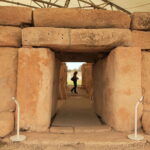| Malta Short Let: Cozy Stay in Gzira | |
|
Sliema Area Modern Designer Finished 2 Bedrooms + Games Room. First floor with Maltese Balcony Large back Terrace with swinging sofa Fully Airconditioned + Full Kitchen 3 TVs, including 65” with backlight. |
 |
|
Book Now: Google Travel | Direct (Cheapest) | Booking.com | Airbnb |
|
The Maltese archipelago, with its labyrinth of Neolithic temples and enigmatic dolmens, remains one of the most captivating prehistoric wonders of the Mediterranean. These structures, scattered across Malta and Gozo, provide not just physical remnants of a bygone era but also glimpses into the spiritual and intellectual lives of their creators. While modern archaeology has tried to interpret their purpose, many questions remain unanswered. With fresh archaeological data and deeper examination, as explored in The Dolmens, Temples, and Cosmic Alignments of Malta, it is possible that Malta’s dolmens, cart ruts, and temple complexes are connected by more than just geography—they may be bound by a cosmic understanding that governed life in the Neolithic period.
The Enigmatic Dolmens: A Forgotten Puzzle
Dolmens, commonly found in Europe and North Africa, are typically seen as tombs. Yet, Maltese dolmens defy this assumption. Unlike their European counterparts, there is no evidence to suggest that the Maltese dolmens were ever used for burials. Instead, their function remains elusive. Their absence in Sicily and presence in North Africa suggests an unexpected migration or cultural exchange in the Mediterranean, making them an “insular specialization” in Malta. This raises the possibility that Malta’s prehistoric societies developed in relative isolation, fostering unique architectural innovations and cultural practices, as discussed in The Forgotten Temple Builders of Malta.
Could these dolmens have served as ritualistic altars or markers of sacred space, tied to the celestial and terrestrial alignments that governed Neolithic life? Their placement near temple complexes and their construction with massive, finely worked stones suggest they played a critical role in the spiritual practices of these early islanders. Some dolmens, such as those near Bugibba and Id-Dawwar, are found in close association with Temple Period sites, including the underground marvel of the Ħal Saflieni Hypogeum, further fueling speculation that their purpose was far more profound than initially believed.
Reassessing Malta’s Sacred Geography: Temple Sites and Their Cosmic Connections
The ancient temples of Malta, particularly Tarxien, Ħaġar Qim, and Mnajdra, exhibit extraordinary architectural sophistication, revealing an advanced understanding of cosmic phenomena. These megalithic structures, some of which date back to 3600 BCE, predate other monumental architectures, including the Egyptian pyramids and Stonehenge, making them among the oldest known freestanding stone structures.
What separates Malta’s temples from similar megalithic monuments is the evidence of their builders’ deep astronomical knowledge. Researchers like David Trump have demonstrated how these temples align with solstice and equinox events. The carefully placed stone slabs, which form intricate apses and passageways, were likely used to mark the changing seasons and celestial events, providing a cosmic calendar that regulated agricultural practices and religious ceremonies. This celestial alignment is further explored in Unveiling Malta’s Neolithic Secrets.
The discovery of spiral motifs at Tarxien is particularly significant. These spirals are not just decorative but appear to be complex symbols reflecting the builders’ understanding of time and the cyclical nature of life and death. These motifs bear a striking resemblance to those found in Mycenaean grave shafts, yet the Maltese spirals predate them by over a millennium. Such artistic parallels suggest that Malta may have been an early cultural hub, exerting influence over regions that later became powerful Mediterranean civilizations.
The Relationship Between the Dolmens and Temples: A Shared Ritual Function?
The close proximity of dolmens to these temple sites suggests a shared function or at least a complementary role in the spiritual life of the Maltese people. While the temples were undoubtedly places of ritual and community gathering, the dolmens may have been used as open-air altars, focal points for offerings, or astronomical markers. Given their modest size, it’s possible that the dolmens served as ceremonial platforms, perhaps for rites connected to fertility or agricultural cycles—a concept central to the Mother Goddess cult that appears to have been a cornerstone of the Temple Period.
Further research, especially at sites like Bugibba, where dolmens are integrated into temple layouts, may uncover more about their enigmatic purpose. Could the dolmens represent an earlier architectural style that evolved into the more complex temple structures, or were they used simultaneously for different but related purposes, one of which might have been tied to the observation of celestial phenomena? This intriguing possibility is examined in The Enigmatic Temples of Malta: Lost Knowledge and Ancient Power.
The Collapse of the Temple Builders: Environmental or Cultural Catastrophe?
The sudden disappearance of the Temple Period culture around 2500 BCE is one of the greatest mysteries in Maltese prehistory. There are various hypotheses—environmental changes, droughts, or even an invasion by an external, more militaristic culture. However, the dolmens, temples, and cart ruts that crisscross the islands suggest a more complex story. Evidence of structural instability and geological shifts across the island, coupled with data showing rapid coastal erosion, points to a society that may have been overwhelmed by natural forces beyond their control, as discussed in Geological Instability and the Maltese Megalithic Structures.
The placement of Malta’s temples, often on elevated ridges or close to cliff edges, might have been a response to these changing landscapes. As sea levels rose and tectonic movements displaced once-stable areas, the Temple Period people may have been forced to adapt, abandon, or rebuild their sacred sites. The dolmens, meanwhile, stand as a testament to their resilience, marking the land long after the temples had been abandoned or repurposed by later Bronze Age cultures.
The Cart Ruts: Pathways to a Lost Civilization
Perhaps the most puzzling feature of Malta’s prehistoric landscape is the network of cart ruts found across the islands, many of which run into the sea. These parallel grooves, cut into the bedrock, remain an enigma. What were they used for? How old are they? Theories abound, ranging from their use in agriculture to their role in transporting goods or building materials for the temples and dolmens. The fact that some ruts vanish into the water suggests that they were carved before the coastline assumed its current form, possibly during a time when Malta’s geography was vastly different.
Could these cart ruts have served as ritual pathways, guiding pilgrims to the island’s sacred sites? Or were they practical tracks used to transport the massive stones that built the temples and dolmens? Their precise function remains speculative, but their alignment with significant geological features indicates that they were more than mere transportation routes.
Experiencing Malta’s Ancient Wonders Today
For modern explorers eager to delve into Malta’s rich prehistoric tapestry, the islands offer not only a journey through time but also comfortable accommodations to enhance your stay. When planning your visit to these ancient sites, consider staying in Sliema or Gzira, vibrant towns that serve as excellent bases for exploration.
In Sliema, you can enjoy a one-bedroom apartment with a traditional Maltese balcony, featuring a comfortable sofa, three TVs, air conditioning, and internet access—perfect for unwinding after a day of discovery. Meanwhile, Gzira offers a designer-finished two-bedroom apartment in a prime location, boasting a 65″ TV, a back terrace, and an internal yard adorned with a captivating mural.
Staying in these modern accommodations allows you to immerse yourself in Malta’s contemporary culture while remaining close to its ancient wonders. From the enigmatic Mnajdra and Ħaġar Qim temples to the subterranean mysteries of the Ħal Saflieni Hypogeum, there’s a wealth of history waiting to be explored.
Conclusion: Reconnecting the Dots of Malta’s Prehistory
The dolmens, temples, and cart ruts of Malta are more than isolated phenomena—they are interwoven threads of a sophisticated Neolithic culture deeply attuned to the rhythms of the earth and sky. As archaeologists continue to study these ancient structures, a clearer picture is emerging of a people who understood the forces that shaped their world, both natural and supernatural.
It seems likely that Malta’s early inhabitants built their temples and dolmens not just to honor their gods but to navigate the profound changes taking place in their environment. By aligning their structures with celestial events, they forged a connection between the heavens and the earth, seeking balance in an ever-shifting world. In doing so, they left behind monuments that continue to fascinate and puzzle us today—monuments that hold the key to understanding a civilization that once flourished at the crossroads of the ancient Mediterranean.
Disclaimer: The content here is based on some theories, interpretations, and speculation. Much of it involves educated guesses, thoughts, and some imagination about Malta’s Neolithic temples and culture. These are not proven facts and may change with new discoveries. These ideas are far from definitive or conclusive.








